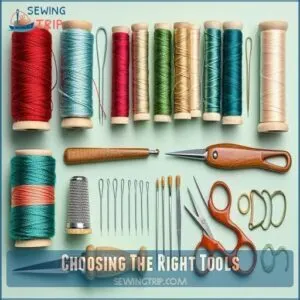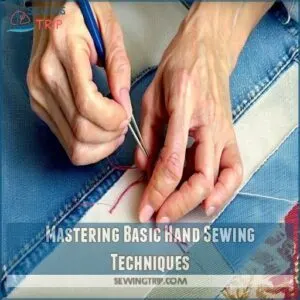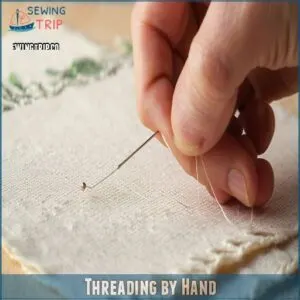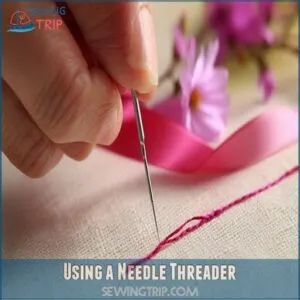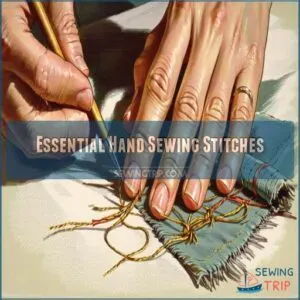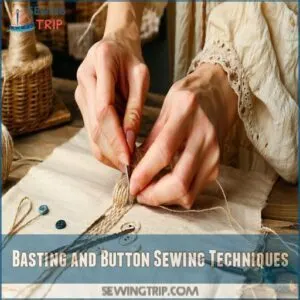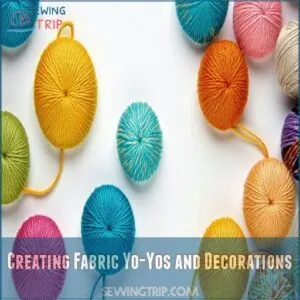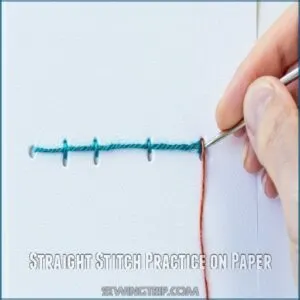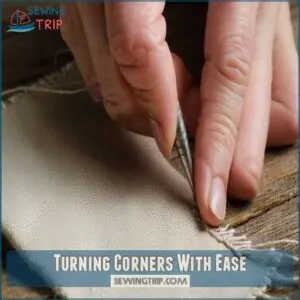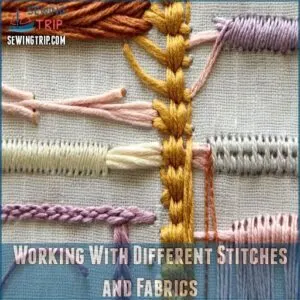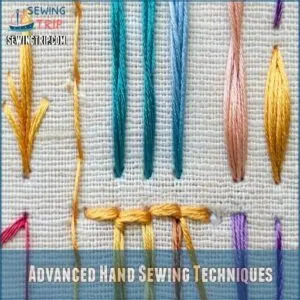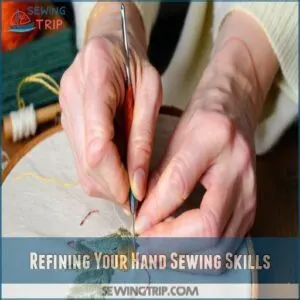This site is supported by our readers. We may earn a commission, at no cost to you, if you purchase through links.
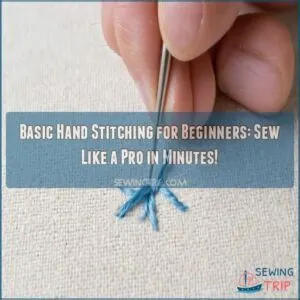
Grab a needle that suits your fabric, some matching thread (or contrast it for fun), and a thimble to save your fingers from tiny, painful “oops” moments.
Begin with the running stitch—it’s as simple as in-and-out and perfect for beginners. Keep your stitches evenly spaced for a cleaner look, and don’t stress if they’re wobbly at first—practice makes perfect!
Once you’re comfortable, try backstitches or ladder stitches for a bit more versatility. Who knows? You might just stitch your way into a new hobby! Learning basic hand stitching is easier than you think. Begin with the running stitch.
Table Of Contents
- Key Takeaways
- Choosing The Right Tools
- Mastering Basic Hand Sewing Techniques
- Threading a Hand Sewing Needle
- Essential Hand Sewing Stitches
- Basting and Button Sewing Techniques
- Creating Fabric Yo-Yos and Decorations
- Practicing Straight Stitches and Corners
- Working With Different Stitches and Fabrics
- Advanced Hand Sewing Techniques
- Refining Your Hand Sewing Skills
- Frequently Asked Questions (FAQs)
- Conclusion
Key Takeaways
- Start with the running stitch—it’s simple, quick to learn, and perfect for beginners to practice consistency and control.
- Choose the right tools: basic needles, matching thread, and a thimble to protect your fingers are all you need to get started.
- Pay attention to stitch tension and needle size to avoid bunching, puckering, or damaging your fabric.
- Practice on fabric scraps or paper to build muscle memory and improve stitch quality over time.
Choosing The Right Tools
You’ll need a few simple tools to start your hand sewing adventure, so don’t worry about getting fancy equipment right away.
Grab some basic needles, thread that matches your fabric, and a thimble to protect your fingers,
and you’ll be stitching like a pro in no time!
Selecting The Best Thread for Hand Sewing
Your thread is the unsung hero of hand sewing, bridging fabric and function with style.
Choose cotton or polyester threads that match your project’s needs – cotton breathes well for natural fabrics, while polyester offers durability for everyday wear.
Color matters too: pick a thread slightly darker than your fabric for invisible mending or a complementary shade for decorative touches.
When selecting the right thread, it’s also essential to keep in mind the needle size, as it affects the overall quality of your stitches.
Choosing The Right Hand Sewing Needles
Hand sewing requires the right needles to achieve success.
Different needle sizes and types matter big time for your project’s success.
Sharp points work best for delicate fabrics, while larger eyes make threading a breeze.
Stainless steel and nickel-plated options offer durability and smooth stitching for beginners and pros alike.
Types of Thimbles for Protection
After picking the perfect needle, protect your fingers with a trusty thimble.
These lifesavers come in different materials to shield you during basic hand stitching adventures.
Choose your weapon wisely:
- Metal thimbles: Tough as nails and built to last
- Leather thimbles: Flexible and comfortable for long sewing sessions
- Plastic thimbles: Lightweight and budget-friendly for beginners
Comfort meets protection in this small but mighty sewing companion.
Mastering Basic Hand Sewing Techniques
You’ll transform your sewing skills from novice to confident craftsperson by mastering basic hand stitching techniques.
Start by focusing on stitch consistency – the secret sauce of professional-looking projects. Learn to control your needle and thread tension like a pro, practicing on scrap fabric to build muscle memory.
Different fabric types require unique approaches, so experiment with lightweight cottons, denim, and delicate silks to understand how stitches behave.
Begin with simple project ideas like pillowcases or tote bags that let you practice basic hand stitching without overwhelming you. The running stitch, an ideal stitch for beginners, is commonly used in projects like lavender bags and heart ornaments.
Pay attention to your hand position, keeping movements smooth and controlled.
Remember, every expert started exactly where you’re now – with patience, practice, and a willingness to learn. Your journey to becoming a skilled hand stitcher begins right here.
Threading a Hand Sewing Needle
Threading your sewing needle doesn’t have to be a frustrating task that makes you want to toss your project across the room!
With a few simple tricks, you’ll be guiding that thread through your needle like a pro in no time.
Threading by Hand
With nimble fingers poised, master hand stitching by threading your needle like a pro.
- Choose a thread color matching or slightly darker than your fabric
- Cut a clean thread end at a sharp angle
- Wet the thread tip for easier needle insertion
- Hold the needle steady and guide the thread through the eye
- Gently pull thread until an equal length emerges on both sides
Using a Needle Threader
Struggling to thread a needle? A needle threader can be your new best friend in hand sewing. These handy tools solve threading challenges for beginners and pros alike.
| Threader Type | Key Benefits | Best For | Ease of Use | Price Range |
|---|---|---|---|---|
| Wire Loop | Quick threading | Thin fabrics | High | $ |
| Automatic | Multiple needle sizes | Varied projects | Medium | $$ |
| Ergonomic | Comfort grip | Frequent sewers | High | $$$ |
| Plastic | Affordable | Beginners | Medium | $ |
| Metal | Durable | Professional use | High | $$ |
Needle threaders: a solution for everyone from beginners to professionals.
Grab a threader and say goodbye to squinting and frustration!
Essential Hand Sewing Stitches
Ready to transform your hand sewing skills from novice to pro?
Master essential stitches like the running stitch, backstitch, and ladder stitch,
and you’ll be mending, creating, and crafting with confidence in no time.
Running Stitch for Beginners
The running stitch is your gateway to hand sewing mastery, transforming fabric with simple, rhythmic movements. Imagine creating seamless lines that dance across your project with confidence:
- Maintain consistent stitch length for professional-looking results
- Control thread tension to prevent bunching or puckering
- Practice on scrap fabric to build muscle memory and speed
- Invest in the right running stitch needle to achieve smooth, even stitches.
Master your running stitch, and you’ll gain the magic of hand stitching in minutes.
Even Backstitch for Straight Lines
Perfecting the even backstitch opens up a world of precise hand sewing techniques.
You’ll want to choose a needle that matches your fabric weight and maintain consistent stitch tension.
Practice on scrap material first, keeping your stitches small and uniform.
Experiment with backstitch variations to discover the most comfortable method for your unique sewing style and project needs.
Ladder Stitch for Mending
Mending magic happens with the ladder stitch, your secret weapon for invisible repairs across fabric types.
You’ll seamlessly close tears by carefully catching fabric edges, keeping stitches hidden and tension even.
Practice makes perfect – start slow, align threads precisely, and watch worn garments transform. This easy hand stitch technique will have you fixing clothes like a pro in no time.
Basting and Button Sewing Techniques
Ever wondered how professional sewers make their projects look flawless?
Learn the magic of basting and button sewing techniques.
that’ll transform your crafting game and have you stitching like a pro in no time!
Temporary Basting Stitches
Now that you’ve mastered some basic stitches, let’s talk basting – your secret weapon for temporary fabric holding. These loose, quick stitches keep fabric in place before permanent sewing.
Basting stitch variations help you:
- Align tricky fabric layers
- Test garment fit
- Hold patterns in place
- Prevent fabric slipping
- Create smooth seam previews
Your fabric’s about to become your canvas – let’s get stitching!
Sewing on Shank Buttons
When working with button shanks, you’ll want to master their unique attachment method.
Shank buttons float above the fabric, creating a raised, decorative look that’s perfect for thicker materials.
To achieve a secure fastening, use a crisscross stitch pattern, which can be easily learned by following a step-by-step guide on how to sew a button.
Secure the button by threading through the shank’s base, keeping your stitches tight and even. Practice your technique to avoid loose connections and achieve a professional finish that’ll make your garment shine.
Sewing on Flat Buttons
Someone might struggle with flat buttons, but mastering button placement is easier than you think.
Start by marking your spot and threading a needle with matching thread.
Having the right flat button sewing supplies can also make a big difference in achieving professional results.
Secure the button through all fabric layers, creating an anchor point. Stitch through each hole multiple times, keeping tension consistent.
For decorative buttons, experiment with thread color and create a sturdy, professional-looking attachment on different fabrics.
Creating Fabric Yo-Yos and Decorations
Ready to turn plain fabric into adorable decorative accents that’ll make your friends go "Wow!"?
Learn how to create charming fabric yo-yos using a simple running stitch.
Transforming ordinary materials into eye-catching embellishments that’ll add a personal touch to everything from pillows to clothing.
Making Fabric Yo-Yos With Running Stitch
After mastering button techniques, you’ll love creating fabric yo-yos with a simple running stitch!
Pick lightweight cotton or quilting scraps for perfect yo-yo size variations.
Gather fabric in the center using small, even running stitches around the circle’s edge. Pull thread tight to create adorable dimensional embellishments.
adorable dimensional embellishments that’ll jazz up pillows, quilts, or accessories with minimal effort.
Exploring Decorative Stitches
By the time you’ve mastered basic hand sewing, you’ll be ready to jazz up your projects with decorative stitches.
Explore creative embroidery ideas that transform ordinary fabric into stunning artwork.
Experiment with unique hand embroidery patterns like chain stitch and cross-stitch.
Your newfound skills will open up a world of advanced designs that’ll make your creations pop with personality.
Practicing Straight Stitches and Corners
Ready to transform your hand-sewing skills from wobbly to wow?
Learn how to master straight stitches and nail perfect corners.
with simple paper practice that’ll have you stitching like a pro in no time.
Straight Stitch Practice on Paper
Grab some sturdy paper and pre-poke holes to avoid tears.
This hand stitch tutorial is perfect for mastering stitch consistency and speed control.
Use a running stitch to practice basic sewing techniques, focusing on even seam allowance. Test different paper types and practice variations.
To improve your basic sewing skills, try using downloadable sewing practice sheets like free sewing practice guides.
These easy hand stitches help build confidence in basic stitching while keeping it fun!
Turning Corners With Ease
Turning corners with ease takes some finesse, but you’ve got this! Mastering pivot tricks and keeping consistent tension are key.
For even more practice, consider starting with a simple project from a pre-made sewing kit.
Follow these steps:
- Secure fabric with a straight stitch.
- Stop at the corner and leave the needle down.
- Rotate fabric smoothly for neat corners.
- Adjust thread tension for different fabric types.
- Practice for flawless hand sewing stitches!
Working With Different Stitches and Fabrics
You’ll quickly notice that different fabrics and stitches can change how your project turns out.
Don’t worry—once you learn a few tricks, you’ll handle slippery silks and thick denim like a pro!
Mastering The Slip Stitch and Overstitch
The slip stitch is your go-to for nearly invisible seams, while the overstitch shines at securing.
Focus on stitch tension control to keep your work neat—too loose, and it puckers; too tight, and it warps.
Experiment with combining stitches to suit the project. Choose fabrics wisely since their thickness impacts results.
Remember to check needle selection based on fabric type to get the best results for your project.
| Stitch Use | Best Stitches | Ideal Tension | Common Fabric Types | Skill Level |
|---|---|---|---|---|
| Seaming edges | Slip stitch variations | Medium | Cotton, linen | Beginner |
| Securing hems | Overstitch applications | Tight | Wool, fleece | Intermediate |
| Invisible closures | Slip stitch | Tight | Silk, satin | Advanced |
| Decorative details | Combining stitches | Variable | Denim, canvas | Expert |
| Stretchy projects | Slip stitch variations | Balanced | Jersey, spandex | Beginner |
Working With Delicate and Thick Fabrics
Handling delicate fabrics? Opt for a fine needle and lightweight thread to avoid snags.
For thick fabrics, choose a sturdy needle and heavier thread weight.
Adjust your stitch tension—too tight can pucker the fabric, while loose stitches mightn’t hold.
Knotting techniques matter too: double knots for thick fabrics, single for thin. Fabric stitching gets smoother with practice!
Advanced Hand Sewing Techniques
Now that you’ve mastered the basics, it’s time to step up your stitching game.
eye-catching techniques like cross-stitch, chain stitch, and the charming French knot.
These decorative skills will add flair to your projects.
and make even the simplest designs look stunning!
Cross-Stitch and Chain Stitch for Decorations
Adding flair to your projects? Cross-stitch and chain stitch provide beautiful ways to decorate with hand sewing. Play with stitch patterns, color choices, and fabric types to keep it fun.
Mastering essential embroidery techniques like mastering thread management is also key for smooth stitching.
- Cross-stitch: X-shaped stitches create bold, grid-like designs.
- Chain stitch: Elegant linked loops for flowy designs.
- Combine stitch variations for unique art.
- Popular for basic embroidery stitches in creative projects.
French Knot for Embellishments
The French knot adds texture and charm to your projects.
Twist your thread just once or twice around the needle—this controls knot size impact.
Try different thread choices to explore French knot variations.
Use these basic embroidery stitches for flowers, stars, or random pops of texture.
Adjust knot density for a subtle or bold effect, perfect for beginners mastering hand sewing stitches.
Refining Your Hand Sewing Skills
Sharpening your hand sewing skills doesn’t have to feel overwhelming—it’s all about tweaking your technique and paying attention to the details.
With a little patience and practice, you’ll be stitching straighter lines and fixing mistakes like a pro in no time!
Tips for Improving Stitch Quality
Keep your stitches consistent by practicing even tension—think of it as finding your sewing rhythm.
Match needle size to fabric choice; a thick needle on delicate fabric is like using a jackhammer on lace.
Monitor stitch density for balance, not overcrowding.
For mastering hand sewing basics, follow sewing tutorials that emphasize basic hand sewing techniques, focusing on even stitches and precision.
Troubleshooting Common Hand Sewing Mistakes
Mistakes happen, but fixing them helps you nail hand sewing basics. Struggling with broken needles or tangled thread? Check your needle size and tension. Uneven stitches? Practice steady hand sewing techniques. Skipped stitches or knotting issues? Use quality thread and proper threading.
Understanding the importance of the correct thread a needle technique can also make a big difference.
Beginner sewing is trial and error—stick with it to master those hand sewing stitches!
- Match needle to fabric.
- Use strong, even thread.
- Practice stitch consistency.
- Adjust tension to avoid tangles.
Frequently Asked Questions (FAQs)
What is the most basic stitch in hand sewing?
Don’t overthink it—start with the running stitch.
It’s simple, quick, and gets the job done.
Just weave your needle in and out of the fabric like you’re drawing little dashes.
That’s it!
What is a hand stitch?
A hand stitch is a simple way to join fabric using a needle and thread.
It gives you control, helps with precise repairs, and allows creative designs.
It’s the “do-it-yourself” magic of sewing!
How do I learn hand stitching?
Start with a needle, thread, and fabric scraps.
Practice easy stitches like the running stitch or backstitch on paper first for control.
Take it slow, follow simple tutorials, and enjoy creating something uniquely yours!
How do I learn sewing by hand?
Grab a needle, thread, and fabric scrap.
Practice basic stitches like running or backstitch on paper first for control.
Watch online tutorials, keep your stitches relaxed, and embrace imperfection—it’s all part of learning!
How do you make a hand stitch?
When threading a needle feels like threading a tiny maze, don’t sweat it.
Pull your thread through, knot the end,
then sew small, even stitches through the fabric, keeping tension steady.
How to make a hand stitch without pinning?
Skip pinning by holding the fabric edges together with your fingers or using clips.
Sew small sections at a time, and adjust your grip as you go.
It’s all about patience and steady hands!
What is the simplest hand stitch?
Think of the running stitch as the bread and butter of hand sewing—it’s simple, quick, and gets the job done.
Just weave your needle in and out of the fabric for a clean, straight line.
How do you start basic stitching?
Grab a needle and thread, knot one end, and hold the fabric steady.
Use small, even stitches, guiding the needle through the fabric.
Keep practicing—it’s like riding a bike, but stabby!
What is the easiest stitch to learn?
Mastering the running stitch is a breeze—it’s the peanut butter and jelly of hand sewing.
It’s just weaving the needle in and out of the fabric, making it perfect for beginners.
It’s perfect for beginners learning control and speed.
What are the 10 basic stitches?
The 10 basic stitches are the running stitch, backstitch, whipstitch, ladder stitch, slip stitch, overcast stitch, blanket stitch, chain stitch, cross-stitch, and catchstitch.
Each one brings unique strength, precision, or flair to your sewing.
Conclusion
Think of hand stitching like learning to ride a bike—wobbly at first, but soon it feels natural.
With just a needle, thread, and a little patience, you’ve mastered a practical skill that’s both creative and useful.
From the running stitch to more advanced techniques, basic hand stitching for beginners opens the door to endless possibilities.
Practice a little each day, and you’ll be repairing, decorating, and crafting in no time. So grab your tools and start stitching!

